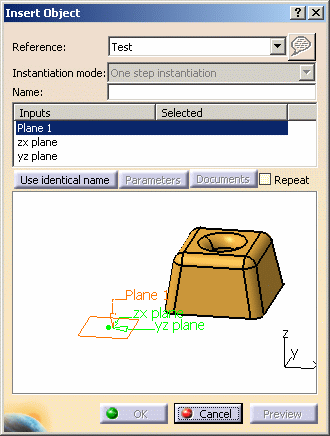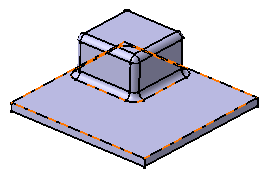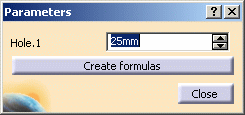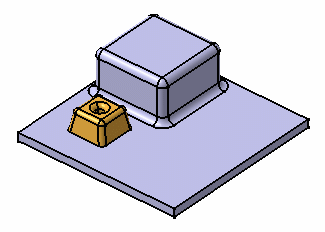There are two ways of doing this:
Using the PowerCopy Instantiate From Document command
-
Select Insert > Instantiate From Document....
The Select PowerCopy dialog box is displayed allowing you to navigate to the document or catalog where the powercopy is stored. Navigate to C:/Program Files/Dassault Systemes/B17doc/online/prtug/samples directory. -
Select the document containing the Powercopy, i.e. PowerCopyResults.CATPart.
The Insert Object dialog box is displayed.
Use the Reference list to choose the correct PowerCopy when several have been defined in the document.
-
Complete the Inputs within the dialog box by selecting the adequate element in the geometric area: select Pad1's upper face as the planar element replacing Plane1.

-
Click on the Use identical name button to automatically select all the elements with the same name. This command searches for features, publications, sub-elements or parameters having the name of the input. If a feature, publication, sub-element or parameter with the input name is found, this element is automatically used as input.
Here, zx plane and yz plane are selected. This is especially useful when the input is the same one repeated several time.
-
Click on the Parameters button to display the Parameters dialog box.

-
Enter 18mm as the new diameter value.
You can use the Create formulas button to automatically create a formula on every parameters with the same name provided there are any. -
Click Close to confirm the operation and close the dialog box.
The Documents button lets you access the list of documents (such as design tables) pointed by one of the elements making up the Power copy.
If there are documents, the Documents dialog box opens and you can click the Replace button to display the File Selection dialog box and navigate to a new design table to replace the initial one.
When no document is referenced, the Documents button is grayed within the Insert Object dialog box. -
Click OK to create the PowerCopy instance.
The PowerCopy is instantiated in context, meaning its limits are automatically re-defined taking into account the elements on which it is instantiated.
Once instantiated, powercopies are no more linked to the original PowerCopies used to define them.
Using a catalog
You need to have a catalog available, created either:
- using the Catalog capability, see the Infrastructure User's Guide.
- using Insert > Knowledge Templates > Save In Catalog...
-
Click Catalog browser
 .
.
If accessing a catalog for the first time, you need to navigate to the catalog location. This location is stored in the settings for faster access later on. -
Select the catalog containing the PowerCopy you wish to instantiate.
-
Select the PowerCopy to be instantiated, then you can:
- double-click the PowerCopy
- or right-click on the PowerCopy in the dialog box and use the Instantiate contextual menu.
From then on, you instantiate the PowerCopy as described above starting on step 3.
To know more about the Insert Object dialog box...
- The Comments & URLs icon is available with user features and document templates only. It is always grayed out when instantiating Power Copies. If a URL was added to a user feature or a Document template, click this icon enables the user to access the URL. To know more about this function, see the Knowledge Advisor User's Guide.
- The Name field enables the user to change the name of the user feature instance.
Recommendations
- Prior to instantiating a powercopy containing a draft created with versions before V5R14, we strongly recommend you to open the CATPart document containing the powercopy, edit the draft, update it and then save the CATPart document in your session.
- Here is a list of the elements you can select for instanciating PowerCopies:
|
Object Can Include |
GS |
OGS |
Body |
Solid Body |
GSM Section |
2D-View Section |
Part |
|
|
GS |
Yes |
No |
No |
Yes |
No |
No |
Yes |
|
|
OGS |
No |
Yes |
Yes |
No |
No |
No |
Yes |
|
|
Body |
No |
Yes |
No |
No |
No |
No |
Yes |
|
|
Solid Body |
No |
No |
No |
No |
No |
No |
Yes |
|
|
Solid |
From Body |
No |
No |
Yes |
No |
No |
No |
No |
|
From Solid Body |
No |
No |
No |
Yes |
||||
|
Volume |
From GS |
Yes |
No |
No |
No |
Yes |
Yes |
No |
|
From OGS |
No |
Yes |
No |
|||||
|
Surface Wire Point |
From GS |
Yes |
No |
No |
No |
Yes |
Yes |
No |
|
From OGS or Body |
No |
Yes |
Yes |
|||||
|
Sketch |
From Body or OGS
|
No |
Yes |
Yes |
No |
Yes |
Yes |
No |
|
From Solid Body or GS |
Yes |
No |
No |
Yes |
||||
|
GSM Section |
Yes |
No |
No |
Yes |
Yes |
No |
Yes |
|
|
2D-View Section |
Yes |
No |
No |
Yes |
No |
Yes |
Yes |
|
|
Section Intersect |
Yes |
Yes |
Yes |
No |
No |
No |
No |
|
|
Section Join |
Yes |
Yes |
Yes |
No |
Yes |
Yes |
No |
|
|
Section Transformation (Axis to Axis) |
Yes |
Yes |
Yes |
No |
Yes |
Yes |
No
|
|
|
2D-View Thickness |
No |
No |
No |
No |
No |
Yes |
No |
|